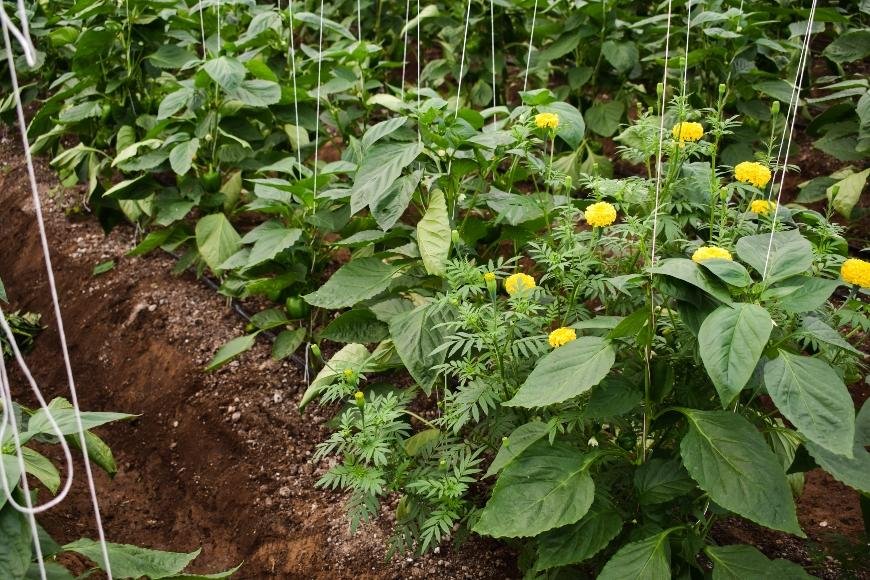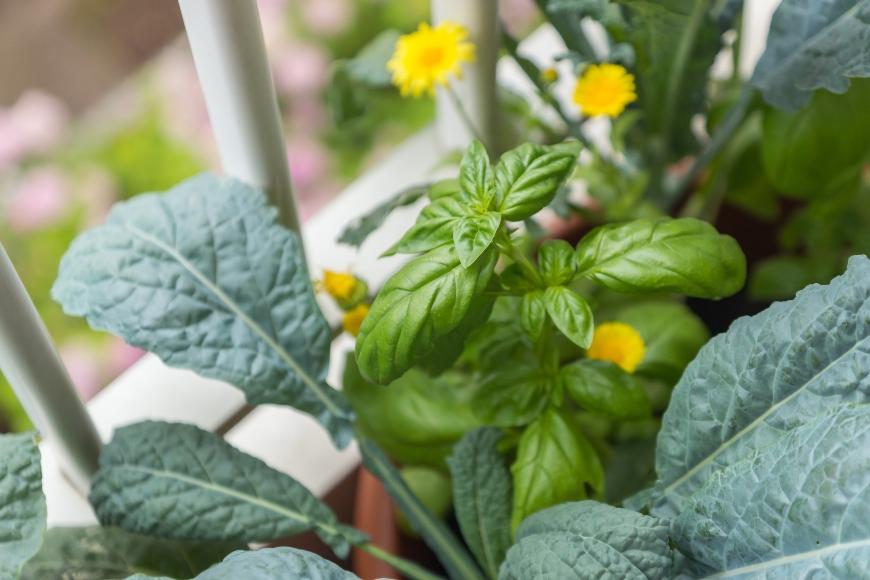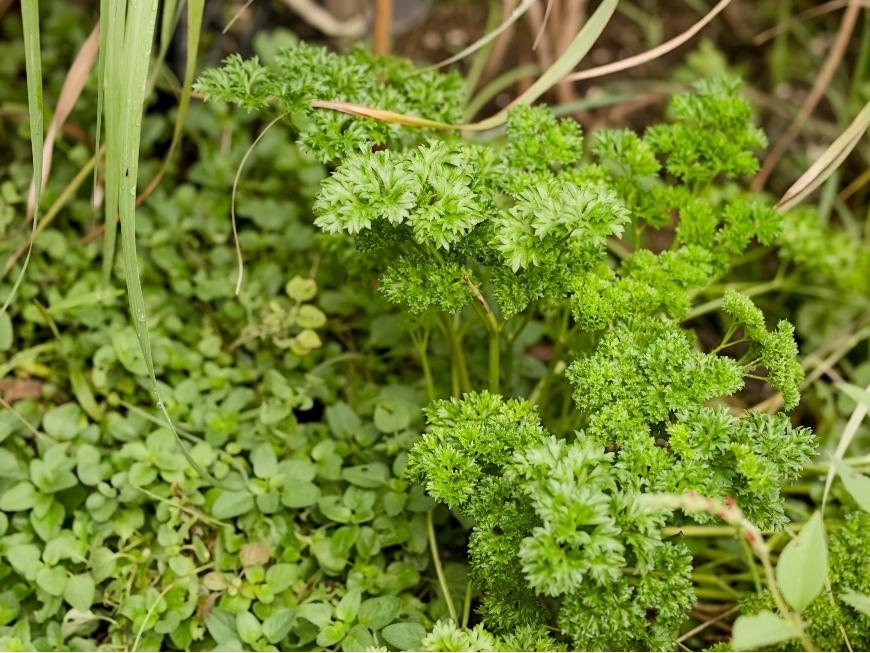How to Grow Better Cannabis With Companion Plants
Discover how to grow better cannabis with companion plants in our comprehensive guide, covering benefits, compatible companions, and tips for a thriving garden.

If you want to learn how to maximize your cannabis garden's potential with companion planting, this post is the perfect guide. This blog post will delve into the world of companion planting and its benefits for your cannabis garden.
Throughout this article, we'll discuss what companion planting is and why it's essential for growing healthy marijuana plants. We'll also cover some popular choices of companion plants that can help your weed plants thrive while providing additional nutrients and attracting beneficial insects.
By understanding how to select compatible companions and plan a successful growing operation, you'll be well on your way to improving soil fertility and reaping the advantages of companion planting for cannabis cultivation. So let's dive in and explore how incorporating surrounding plants can take your grow room to new heights!
Table of Contents:
- Companion Planting: A Sustainable Approach to Cannabis Cultivation
- Companion Planting: A Boost for Your Cannabis Garden
- Companion Plants for a Thriving Cannabis Garden
- Improving Soil Fertility with Companion Plants
- Selecting Compatible Companions
- Planning for Successful Companion Planting
- Companion Planting: A Natural Way to Boost Your Cannabis Garden
- FAQs in Relation to How to Grow Better Cannabis With Companion Plants
- Conclusion
Companion Planting: A Sustainable Approach to Cannabis Cultivation
Companion planting is an ancient gardening technique that involves growing different plants together to create a more diverse and balanced ecosystem. This method can promote healthier plant growth, improve soil quality, and increase the yield of your cannabis crop. By incorporating companion plants into your garden, you can create a more resilient environment where both cannabis and its companions thrive.

What is Companion Planting?
The concept behind companion planting is that certain plants can benefit each other when grown together. These beneficial relationships may include providing nutrients, attracting pollinators or predatory insects, repelling pests, or offering physical support. When it comes to cannabis cultivation, companion planting can help with pest control, enhance nutrient uptake, and improve overall soil health.
Benefits of Companion Planting for Cannabis
- Pest Control: Some companion plants release chemicals or emit scents that deter common pests from attacking your cannabis crop.
- Nutrient Uptake: Certain companions are known as "dynamic accumulators," meaning they draw up essential nutrients from deep within the soil profile which then become available for nearby plants like cannabis.
- Soil Health: Incorporating a variety of plants into your garden can help improve soil structure, prevent erosion, and promote the growth of beneficial microorganisms.
- Pollination: Attracting pollinators such as bees and butterflies to your cannabis garden can increase the chances of successful pollination and potentially boost yields.
Why Try Companion Planting?
Incorporating companion planting into your cannabis cultivation can not only help to protect the environment but also potentially increase yields, making it an attractive option for cannabis growers. Some studies have shown that increasing biodiversity within agricultural systems can lead to higher yields. So why not give it a try? With some research, planning, and careful selection of compatible companions, you'll be well on your way to growing better cannabis through companion planting.
Companion Planting: A Boost for Your Cannabis Garden
Companion planting is a smart way to enhance the health and yield of your cannabis crop. By introducing companion plants, you can create a more balanced and resilient ecosystem that benefits your plants in many ways.
Pest Control
Some companion plants emit strong odors or produce chemicals that repel harmful insects, reducing the need for chemical pesticides. For example, marigolds release limonene, which wards off aphids and whiteflies. This natural form of pest control keeps your plants healthier.
Nutrient Uptake
Companion plants with deep root systems bring essential nutrients closer to the surface, making them more accessible to cannabis roots. Plants like comfrey can help increase nutrient availability in healthy soil.
Improved Soil Health
Many companion plants contribute organic matter to the soil as they decompose, enriching it with vital nutrients needed for healthy plant growth. Legumes such as clover fix nitrogen from the atmosphere into forms that other plants can use, improving overall soil fertility.
Increase Pollination
Flowering companion plants attract pollinators like bees and butterflies, which play an essential role in maintaining biodiversity within your garden ecosystem. Beneficial bugs can not only help with pollination, but they can also assist in pest control by feeding on them or hindering their life cycles.
Some popular companion plants for cannabis include:
- Basil: This aromatic herb attracts beneficial insects while deterring pests like thrips and spider mites.
- Lavender: Known for its calming scent, lavender can help repel pests such as moths and aphids while attracting pollinators like bees.
- Rosemary: This versatile herb helps deter a variety of pests including cabbage moths, carrot flies, and whiteflies.
Incorporating companion plants into your cannabis garden not only provides these benefits but also contributes to a more aesthetically pleasing environment. The combination of various plant species creates a visually appealing landscape that is both functional and enjoyable to maintain. By embracing the principles of companion planting, you can cultivate healthier cannabis plants with potentially higher yields in an eco-friendly manner.
Companion Plants for a Thriving Cannabis Garden
When growing cannabis, incorporating companion plants can boost the health and yield of your garden. These plants provide natural protection against pests and diseases while attracting beneficial insects that promote a balanced ecosystem. Here are some popular companion plants to consider:
Marigold
Known for their bright colors and pleasant scent, marigolds have been used as a natural pest deterrent in gardens for centuries. Marigolds repel pests while basil attracts beneficial predators, making them both effective options for pest control.
Basil
This aromatic herb is another excellent choice for keeping pests at bay. Basil's strong scent helps deter flies, mosquitoes, thrips, and other unwanted visitors from your cannabis plants. Plus, it makes a delicious addition to any kitchen.
Lavender
Lavender's delightful scent not only repels insects, but also attracts beneficial pollinators such as bees. Its aroma confuses pests like moths and fleas while attracting pollinators such as bees.
Rosemary
Another fragrant herb with multiple benefits. Rosemary helps ward off various insects, including cabbage moths and carrot flies, while promoting healthy root growth in nearby plants.
Lemon Balm, Dill, and Chamomile
These plants also help protect your cannabis from pests and contribute to a more diverse and resilient garden ecosystem.
When selecting companion plants, consider their growing requirements to ensure that both the cannabis and its companions can thrive together without competing for resources. Additionally, some companion plants may even improve nutrient uptake by helping break down organic matter in the soil or fixing nitrogen through their root systems.
By incorporating these compatible companions into your cannabis garden, you'll create a healthier environment for your plants while potentially increasing yields. So why not give companion planting a try? Your garden (and stash) will thank you.
Improving Soil Fertility with Companion Plants
Companion planting can improve soil fertility, leading to healthier cannabis plants. Choosing specific companion plants that contribute to nutrient availability and uptake can create a more productive garden ecosystem.
Legumes like beans and peas are excellent companions for cannabis. They fix nitrogen from the atmosphere into the soil, an essential macronutrient for plant growth, especially during the vegetative stage. By increasing nitrogen levels naturally through legume companionship, you can reduce or eliminate synthetic fertilizers' need.
Dynamic accumulators like comfrey and yarrow are another group of beneficial companion plants. They draw up nutrients from deeper layers of soil that may be inaccessible to other shallow-rooted species like cannabis. As these plants decompose on topsoil or are used as mulch around your cannabis plants, they release their stored nutrients back into the soil's upper layers where it becomes available for uptake by nearby crops.
- Comfrey: A powerful dynamic accumulator rich in potassium, phosphorus, calcium, and trace minerals.
- Borage: Attracts pollinators while providing high amounts of calcium and potassium when used as mulch or compost material.
- Clover: Fixes nitrogen in addition to attracting beneficial insects such as ladybugs and lacewings.
- Chamomile: Improves soil structure, attracts pollinators, and contains calcium, potassium, and sulfur.
Some companion plants also help with pest control. For example, marigolds produce a substance called alpha-terthienyl that is toxic to nematodes - microscopic worms that can damage cannabis roots. By planting marigolds around your cannabis plants or incorporating them into crop rotations within your garden space, you can minimize nematode populations naturally without resorting to chemical treatments.
Selecting compatible companion plants for your cannabis garden based on their ability to improve soil fertility and support healthy plant growth through natural means like nitrogen fixation or dynamic accumulation of nutrients from deeper layers of soil can create a more balanced ecosystem where all inhabitants thrive together harmoniously.
Selecting Compatible Companions
When growing cannabis with companion plants, it's crucial to choose compatible companions with similar growing requirements. This ensures that both your cannabis and companion plants can thrive together without competing for resources or negatively impacting each other's growth.
Cannabis prefers well-draining soil and moderate amounts of water. Avoid planting moisture-loving species like mint nearby, as they could lead to overwatering issues. Instead, opt for drought-tolerant herbs such as rosemary or lavender, which require similar watering schedules.
Consider the size of your plants at maturity when planning your garden layout. Some taller companion plants may provide shade benefits for heat-sensitive strains during hot summer months, while others might compete with cannabis for sunlight if not properly spaced apart.
Companion Plants to Consider
- Marigolds: These bright flowers deter pests like whiteflies and nematodes while attracting beneficial insects such as ladybugs.
- Basil: A popular herb known for repelling mosquitoes and aphids while also improving the flavor profile of neighboring crops.
- Lavender: This fragrant plant attracts pollinators like bees while deterring pests including spider mites and aphids due to its strong scent.
- Lemongrass: Known for its citronella content, lemongrass repels mosquitoes and other pests while also helping to mask the smell of cannabis.
It's important to research each potential companion plant before introducing it into your garden. Some plants may have allelopathic properties, meaning they release chemicals that can inhibit the growth of nearby plants. For example, fennel is known to be allelopathic and should not be planted near cannabis or most other vegetables.
Comprehensive lists of compatible companions are available online as a starting point for planning your ideal garden ecosystem. By carefully selecting suitable companion plants based on their benefits and growing requirements, you'll create a more balanced environment where both your cannabis and its companions can flourish together.

Planning for Successful Companion Planting
To ensure a successful companion planting strategy, invest time in planning and research. This creates a balanced and resilient garden ecosystem, leading to healthier cannabis plants and potentially higher yields.
Research and Create a List
Research various companion plants suitable for cannabis cultivation. Look into their benefits such as pest control, nutrient uptake improvement, pollination enhancement, or disease prevention. Compile a list of compatible companions based on your research findings. Keep in mind factors like regional climate and specific pests common to your area.
Garden Layout and Maintenance Plan
Design your garden layout with both cannabis and companion plants in mind. Plan out where each type should be planted relative to one another for maximum benefit while avoiding overcrowding or competition for resources. Develop a maintenance plan that accounts for watering schedules, fertilization needs (if necessary), pruning practices, or harvesting times so all species thrive harmoniously together without hindering each other's growth.
Incorporate Permaculture Principles
In addition to these steps, consider incorporating permaculture principles into your garden design. Permaculture is an ecological approach focused on creating sustainable systems through mimicking natural ecosystems' patterns. It can help you create a more resilient and productive garden by encouraging biodiversity, recycling nutrients, and promoting natural pest control.
Experiment and Refine
Don't be hesitant to try out different groupings of plants that grow together. Trial and error is often the best way to discover what works best for your specific growing conditions. Keep track of your successes (and failures) so that you can refine your approach over time.
By carefully planning and implementing a successful companion planting strategy, you'll be well on your way to cultivating healthier cannabis plants while also contributing positively to the environment around them.
Companion Planting: A Natural Way to Boost Your Cannabis Garden
Companion planting can do wonders for your cannabis garden. By creating a balanced ecosystem, you can promote healthier plants and potentially higher yields. Here are some benefits of companion planting:
Natural Pest Control
Marigolds and lavender emit scents that repel pests like aphids, whiteflies, and spider mites. This reduces the need for chemical pesticides, which can harm beneficial insects and your cannabis plants.
Promoting Beneficial Insects
Plants like basil attract pollinators and predatory insects that feed on common pests. These "good bugs" help keep harmful insect populations under control while also aiding in pollination.
Disease Prevention
Some companions have natural antifungal properties, such as rosemary, which can help protect your cannabis from diseases like powdery mildew or mold.
Better Nutrient Uptake
Legumes like clover fix nitrogen in the soil, making it available to neighboring plants, including your cannabis. This promotes strong growth and development.
Maintaining Soil Health
Deep-rooted cover crops like alfalfa break up compacted soil layers, improving drainage and root penetration while also preventing erosion.
For successful companion planting, choose compatible plant species with similar growing requirements. This ensures that your cannabis plants and their companions can coexist harmoniously, each contributing to the overall health of the garden ecosystem.
Remember, planning and research are key to successful companion planting. With a well-thought-out strategy in place, you'll be on your way to cultivating healthier, more resilient cannabis plants with higher yields - all while promoting biodiversity in your garden.
FAQs in Relation to How to Grow Better Cannabis With Companion Plants
What plants grow well alongside cannabis?
Cannabis thrives when grown with companion plants like basil, marigolds, yarrow, and alfalfa, which offer benefits such as pest control, improved soil fertility, and increased biodiversity.
How does companion planting improve soil?
Companion planting improves soil by promoting nutrient cycling and increasing organic matter content through nitrogen fixation and root exudates.
Can you plant garlic with cannabis?
Yes, garlic is an excellent companion plant for cannabis as it repels pests like aphids and spider mites while also acting as a natural fungicide to prevent diseases.
Is oregano a good companion plant for cannabis?
Oregano deters harmful insects like whiteflies and attracts beneficial predators such as ladybugs that prey on common pests affecting pot growth.
Conclusion
Now you know how to grow better cannabis with companion plants. Want to grow better cannabis? Try companion planting to improve soil fertility and increase yields. Companion planting involves selecting compatible plants that can benefit each other when grown together. For cannabis cultivation, some great companion plants include marigolds, basil, and chamomile.
These plants can help deter pests naturally, promote a healthier ecosystem, and even improve the flavor of your cannabis. So why not give companion planting a try and see the benefits for yourself?



































































































































